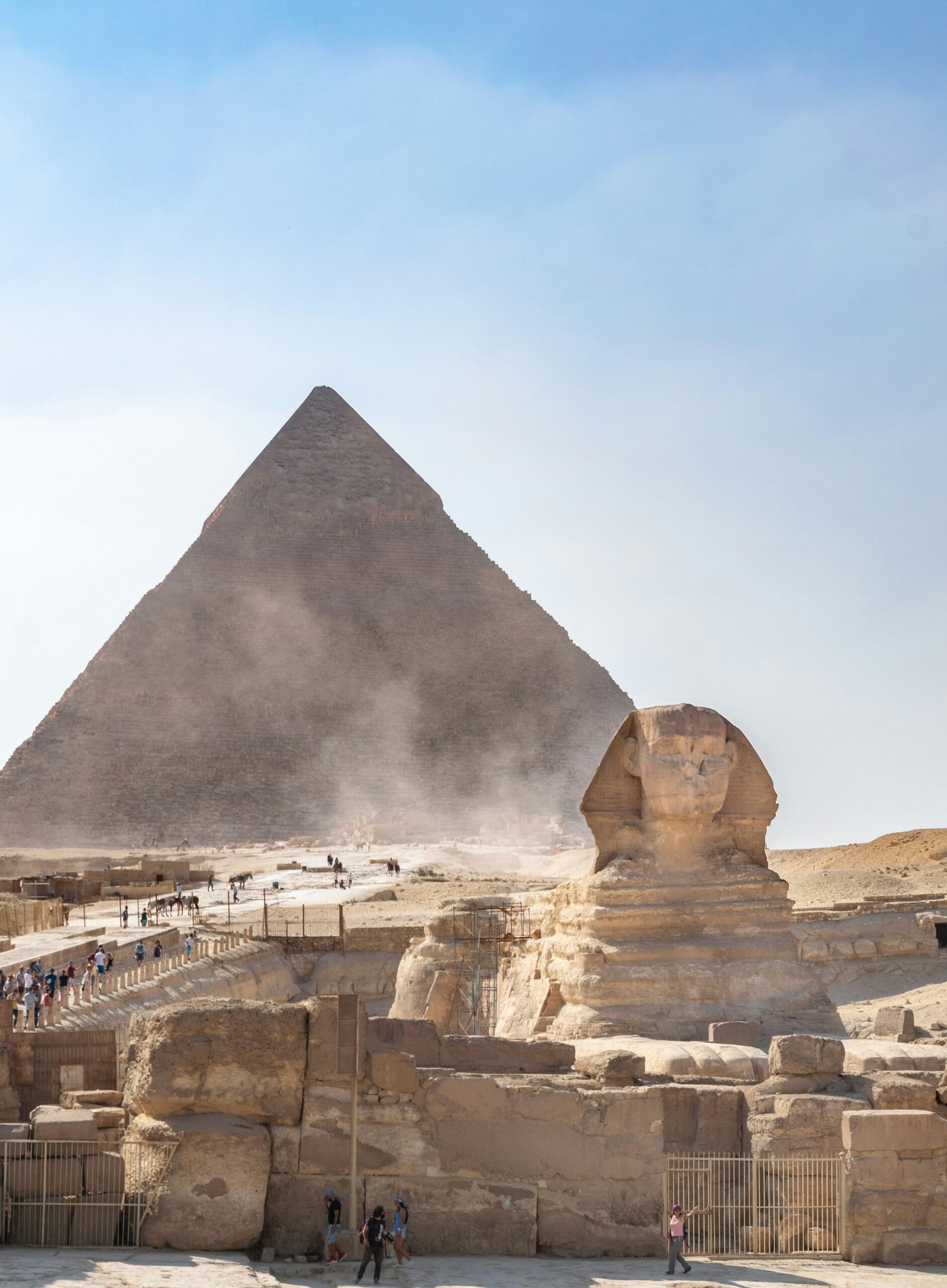
Constructed over 4,500 years ago, the Great Pyramid of Giza is the oldest and largest of the three pyramids on the Giza Plateau. It was built as a tomb for the Pharaoh Khufu, also known as Cheops, who ruled during the Fourth Dynasty of the Old Kingdom of Egypt. The pyramid is a testament to the incredible engineering and architectural skills of the ancient Egyptians.
The sheer size of the Great Pyramid is mind-boggling. It originally stood at an impressive height of 481 feet (146 meters), making it the tallest man-made structure in the world for over 3,800 years until the completion of the Lincoln Cathedral in England. The pyramid’s base covers an area of 13 acres (5.3 hectares), equivalent to approximately 10 football fields. To put it into perspective, the pyramid is estimated to have been built using around 2.3 million stone blocks, each weighing an average of 2.5 tons.
One of the most fascinating aspects of the Great Pyramid is its precise alignment with the cardinal points of the compass. Its sides are almost perfectly oriented to the north, south, east, and west, with only a slight deviation due to natural shifts in the Earth’s crust over the centuries. This remarkable accuracy is a testament to the advanced astronomical knowledge possessed by the ancient Egyptians.
The construction of the Great Pyramid involved an immense amount of labor and resources. It is believed that tens of thousands of workers, including skilled craftsmen, engineers, and laborers, were involved in its construction. The pyramid was built using a combination of limestone and granite blocks, which were quarried from nearby locations and transported to the site using a system of ramps and sledges. The precision with which the blocks were cut and fitted together is truly remarkable, with some joints being so tight that not even a piece of paper can fit between them.
Inside the Great Pyramid, there are several chambers and passageways, including the King’s Chamber, the Queen’s Chamber, and the Grand Gallery. The purpose of these chambers and their intricate architectural features continue to be a subject of debate among Egyptologists and historians. Some believe that they served as burial chambers for the pharaoh and his family, while others propose alternative theories, such as the pyramid being a symbolic representation of the pharaoh’s journey to the afterlife.
Today, the Great Pyramid of Giza stands as a testament to the ingenuity and grandeur of ancient Egypt. It is not only a UNESCO World Heritage Site but also one of the Seven Wonders of the Ancient World. Visitors from all corners of the globe flock to witness this architectural marvel, marveling at its sheer size, precision, and the mysteries it continues to hold.
Ancient Engineering Marvel
Constructed around 4,500 years ago, the Great Pyramid of Giza is the largest of the three pyramids in the Giza pyramid complex. It was built as a tomb for the Pharaoh Khufu, who ruled during the Fourth Dynasty of the Old Kingdom of Egypt.
The sheer scale and precision of the construction of the Great Pyramid is a testament to the advanced engineering skills of the ancient Egyptians. The pyramid was built using an estimated 2.3 million stone blocks, each weighing an average of 2.5 tons. The stones were carefully cut and transported from quarries located miles away, and then meticulously stacked to create the pyramid’s impressive structure.
One of the most remarkable aspects of the Great Pyramid is its alignment with the cardinal points of the compass. The pyramid’s sides are oriented to face true north, south, east, and west with an incredible accuracy of less than 0.1 degrees. This alignment demonstrates the ancient Egyptians’ deep understanding of astronomy and their ability to incorporate celestial observations into their architectural designs.
Furthermore, the Great Pyramid’s construction techniques were highly sophisticated for their time. The Egyptians employed a system of ramps and pulleys to move the massive stone blocks into place. These ramps were ingeniously designed to allow the workers to gradually increase the height of the pyramid as construction progressed. The precision required to align the stones and ensure the stability of the structure is truly remarkable, considering the limited tools and technology available at the time.
Additionally, the interior of the Great Pyramid is equally impressive. It contains a series of intricate passageways and chambers, including the King’s Chamber and the Queen’s Chamber. These chambers were built with such precision that they have withstood the test of time, remaining intact for thousands of years.
Another intriguing aspect of the Great Pyramid is its mathematical significance. The ratio of the pyramid’s height to half its base is approximately equal to the mathematical constant pi (π). This mathematical connection suggests that the ancient Egyptians possessed advanced mathematical knowledge and were able to incorporate it into their architectural designs.
Overall, the Great Pyramid of Giza stands as a testament to the ingenuity and skill of the ancient Egyptians. Its construction techniques, precise alignment, and mathematical significance continue to captivate and inspire awe in people around the world. The pyramid serves as a reminder of the remarkable achievements of our ancestors and the enduring legacy they have left behind.
The intricate design and construction of the Great Pyramid of Giza reflect the immense power and belief system of ancient Egypt. The pyramid’s massive size and precise alignment with the cardinal directions demonstrate the advanced engineering skills of the ancient Egyptians. The pyramid’s exterior, originally covered in smooth white limestone, would have glimmered in the sunlight, making it a striking symbol of the pharaoh’s authority and divinity.
Beyond its physical attributes, the Great Pyramid also held deep religious and spiritual significance. The pyramid was not only a tomb for the pharaoh but also a sacred space where his soul could transcend to the afterlife. The ancient Egyptians believed that the pharaoh, as a divine ruler, would join the gods in the heavens after death. The pyramid, with its towering height and majestic presence, was seen as a gateway for the pharaoh’s soul to ascend to the realm of the gods.
Inside the Great Pyramid, the King’s Chamber stands as a testament to the grandeur and mystery of ancient Egyptian burial practices. This chamber, constructed entirely of red granite, was intended to house the pharaoh’s sarcophagus. While the sarcophagus is empty, it is believed to have once held the remains of Pharaoh Khufu, the pyramid’s builder. The King’s Chamber, with its intricate carvings and symbolic decorations, was a sacred space where rituals and ceremonies may have been performed to ensure the pharaoh’s safe passage to the afterlife.
One of the most intriguing features of the Great Pyramid is the Great Gallery, a long, sloping passageway that leads to the King’s Chamber. This gallery, with its high ceiling and corbelled walls, has puzzled researchers for centuries. The purpose of the Great Gallery remains a subject of debate, with various theories proposed. Some suggest that it served as a ramp for transporting the massive granite blocks used in the construction of the pyramid. Others believe it had a ceremonial or symbolic function, perhaps representing the pharaoh’s ascent to the heavens or the journey of the soul to the afterlife.
Regardless of its exact purpose, the Great Gallery adds to the enigmatic allure of the Great Pyramid of Giza. It is a testament to the ingenuity and architectural prowess of the ancient Egyptians, who were able to create such a monumental structure with limited tools and resources. The Great Pyramid stands as a lasting symbol of the power and belief system of ancient Egypt, a testament to the pharaoh’s divine status and the enduring legacy of one of the world’s most remarkable civilizations.
Preserving the legacy of the Great Pyramid of Giza is not an easy task, but it is one that is of utmost importance. As a UNESCO World Heritage Site, the pyramid holds immense historical and cultural value, and it is our responsibility to protect it for future generations.
One of the biggest challenges in preserving the pyramid is natural erosion. Over the centuries, wind, rain, and sand have taken their toll on the structure, wearing away at its surface. To combat this, conservationists have implemented various measures. One such measure is the application of protective coatings on the pyramid’s exterior. These coatings not only help to prevent erosion but also act as a barrier against pollution and other environmental factors.
Another threat to the pyramid’s preservation is looting. Throughout history, the pyramid has been a target for treasure hunters and grave robbers, who sought to plunder its riches. To combat this, security measures have been put in place, including increased surveillance and the establishment of a dedicated team of guards. Additionally, efforts are being made to raise awareness about the importance of preserving the pyramid, both locally and internationally, in order to discourage looting.
Furthermore, there have been instances where the Great Pyramid of Giza has faced attempts at destruction. In the past, invaders and conquerors sought to demolish the pyramid, viewing it as a symbol of power and authority. However, these attempts were largely unsuccessful, thanks to the pyramid’s sturdy construction and the dedication of those who fought to protect it. Today, the pyramid stands as a symbol of resilience and defiance against those who sought to destroy it.
In addition to these challenges, the Great Pyramid of Giza also faces the pressure of tourism. While the influx of visitors brings economic benefits to the surrounding area, it also poses a risk to the pyramid’s preservation. To address this, sustainable tourism practices are being implemented. These practices include limiting the number of visitors allowed inside the pyramid at a time, as well as providing educational materials and guided tours to ensure that visitors understand the historical significance of the site and the importance of treating it with respect.
Preserving the legacy of the Great Pyramid of Giza requires a multi-faceted approach. It involves not only physical conservation efforts but also raising awareness, implementing security measures, and promoting responsible tourism. By taking these steps, we can ensure that this ancient wonder continues to inspire awe and wonder for generations to come.
As you approach the Great Pyramid of Giza, its sheer size and scale become even more apparent. The pyramid stands at an impressive height of 481 feet, towering over the surrounding landscape. Its base covers an area of over 13 acres, making it one of the largest man-made structures in the world.
Constructed over 4,500 years ago, the Great Pyramid was built as a tomb for the pharaoh Khufu, who reigned during the Fourth Dynasty of the Old Kingdom of Egypt. The precision and expertise required to construct such a monumental structure are truly mind-boggling. Each massive limestone block was carefully cut and shaped to fit together seamlessly, creating a solid and enduring monument that has withstood the test of time.
One can’t help but wonder how the ancient Egyptians managed to accomplish such a feat without the modern technology and machinery that we have today. The construction of the Great Pyramid required an immense amount of planning, organization, and labor. It is estimated that it took thousands of workers over 20 years to complete the pyramid, with each block weighing an average of 2.5 tons.
Inside the pyramid, a labyrinth of passageways and chambers awaits exploration. The intricate network of corridors leads to the burial chamber, where the pharaoh’s sarcophagus was once housed. Although the treasures that once adorned the chamber have long been looted, the sheer magnitude of the space is awe-inspiring.
As you stand inside the pyramid, you can’t help but feel a sense of reverence and wonder for the ancient Egyptians who dedicated their lives to the construction of this monumental structure. The Great Pyramid of Giza is not only a testament to their architectural prowess but also a reflection of their belief in the afterlife and the importance they placed on honoring their pharaohs.
Today, the Great Pyramid continues to draw visitors from around the world who come to marvel at its grandeur and unravel the mysteries of its construction. It serves as a reminder of the rich history and cultural heritage of ancient Egypt, offering a glimpse into a civilization that thrived thousands of years ago.



